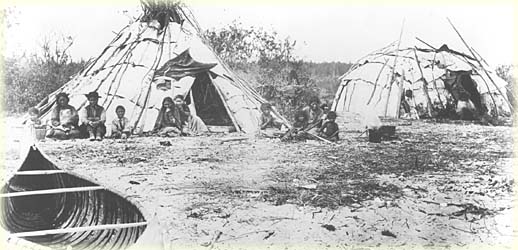
|


|


|

|

|
|
Middle Shield Culture (Précis, Chapter 16)
Shield culture represented the first
significant human occupation of the Canadian Shield, an enormous
region encompassing a southwestern portion of the Northwest Territories,
most of Manitoba, northern Ontario, northern Québec including
a portion of the northshore of the St. Lawrence, and Labrador
(Wright 1972;
1981). Shield culture developed
out of the Plano culture of southern Keewatin District and eastern
Manitoba around 6,000 B.C. Elements of this development involved a
dependency upon caribou and fish supported by a generalized adaptation
to the ecosystems of the Canadian Shield
(see Feit 1973). Western bands
of Shield culture gradually occupied the Canadian Shield as it was
released from the glacial ice and associated bodies of water and was
colonized by plant communities and their associated faunas. This
incremental process resulted in the occupation of the Canadian Shield
following a west to east cline with the Hudson Bay Lowlands of Ontario
and much of Québec and Labrador not being settled until around
2,000 B.C. The Cree, Ojibwa, Algonkin, Montagnais, and the Beothuck
of the time of European contact are regarded as the direct descendants
of Shield culture. The close cultural and linguistic affinities between
the aforementioned people, exclusive of the Beothuck who became extinct
before their language could be properly studied, reflects the
exceptional degree to which Shield cultural systems were interconnected
throughout a region that covers nearly half of Canada. Factors favouring
this 'sameness' were as follows: the association of major food resources
with the interconnecting waterways of the Canadian Shield that also
functioned as the communication routes in both summer and winter; a
broadly adapted subsistence pattern centred on caribou and fish that
required considerable territory for small bands of people due to
fluctuations in caribou populations compounded by the erratic impact
of endemic and often massive forest fires; a flexible social system
favouring wide-ranging relationships that was cemented by interband
marriages; limited cultural intrusions or influences from neighbouring
cultures; and the late colonization of much of the eastern Canadian
Shield.
|

|
|
Northern Algonquian Camp
Settlement pattern evidence suggests
that Middle Shield culture people followed a way of life essentially
the same as that of the Cree, Ojibwa, Algonkin, and Montagnais
peoples documented by Europeans observers. With few exceptions only
the vaguest evidence of dwellings, such as the bark covered
structures in the photograph, has survived in the archaeological
record. No trace of the bark canoe, so essential to travel in the
vast tracts of the Canadian Shield, has ever been recovered.
Manufactured from wood, bark, and leather the majority of the
sophisticated technology required for survival has simply vanished
from the archaeological record. Note also that the camp is situated
on an active beach that would be awash part of the year further
dispersing the sparse evidence of human occupation.
(Canadian Museum of Civilization, Canadian Ethnology Service,
Negative 594: T. L. Weston, 1884, Jackfish River, Lake Winnipeg,
Swampy Cree?)
|
|
|
The technology of Middle Shield culture is characterized by chipped
stone knives, scrapers, and projectile points and a general absence
of tools formed by stone grinding. As with most cultures, the major
tool category was the unmodified flake whose naturally sharp edges
could be used for a wide range of cutting, scraping, and slotting
tasks. Native copper implements are particularly common on sites in
proximity to the copper sources of Lake Superior. There is also
evidence of an extensive trade in copper to Middle Great Lakes-St.
Lawrence culture populations in the Ottawa Valley. Through time
there appears to be an increase in the number of scrapers and
side-notched projectile points at the expense of large bifacially
flaked knives and lanceolate points. Bone in any form is usually
absent except as small calcined fragments. As a result, the
inference of a reliance upon caribou and fish must be based upon
settlement pattern distributions. A number of caches of stone and
copper implements found in Manitoba, Ontario, and Québec are
interpreted as 'boneless' graves where acid soils have dissolved
the bone. One of the Manitoba sites did contain some human remains.
Red ochre, chipped stone tool kits often including items
manufactured from Knife River chalcedony from North Dakota and
native copper implements, characterizes these features in Manitoba
and Ontario suggesting that by 2,000 B.C. elaborate mortuary
ritualism was being practiced by at least those Middle Shield
culture populations bordering the more southerly centres of
ceremonial elaboration.
Middle Shield culture dwellings ranged from substantial
semi-subterranean structures with excavated entrance-ways to very
flimsy dwellings that have left little archaeological trace.
Settlement pattern distributions do not change in most areas of the
Canadian Shield from the earliest human occupation up to the time of
European contact indicating that subsistence rounds had been
relatively stable over thousands of years. Given the relatively
consistent nature of animal behaviour and the stability of the land
forms such a situation is not surprising. Unfortunately stratified
sites are a rare occurrence and most sites consist of hopelessly
mixed cultural debris of untold numbers of campsites representing
thousands of years of seasonal occupations. This difficulty of
component isolation is the single most serious limitation facing
Canadian Shield archaeology.
The Parklands along the southwestern flank of the Middle Shield
culture distribution and the Great Lakes-St. Lawrence vegetation
province
(McAndrews et al. 1987:
Plate 4) flanking the southeastern border have acted as major areas
of contact between different cultures. These cultural boundaries
shifted through time as a result of climatically induced conditions
that were either advantageous or disadvantageous to different
cultural adaptations. While the cultural homogeneity of Middle
Shield culture has been emphasized there is regionalism that is
most pronounced along the southern boundaries of the Middle Shield
cultural distribution where influences from neighbouring cultures
were most intense. Regional differences are to be expected within
a cultural construct with the space and time dimensions proposed
for Shield culture but these differences would appear to be minor
relative to the shared cultural characteristics.
|
|
|
|
|